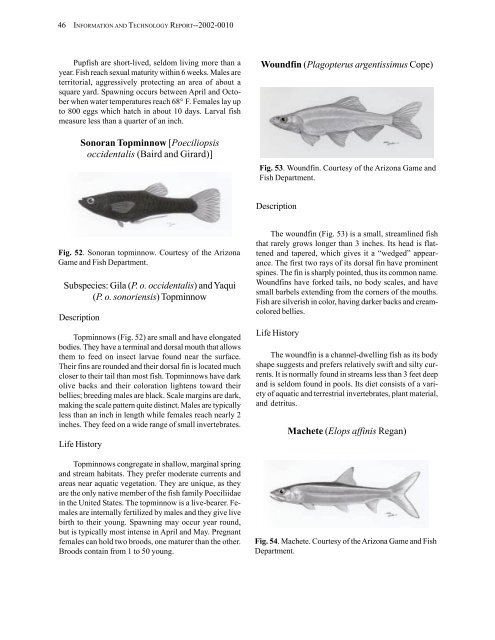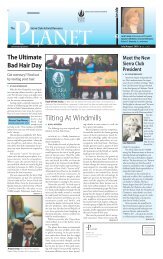Lost, A Desert River and its Native Fishes - Sierra Club
Lost, A Desert River and its Native Fishes - Sierra Club
Lost, A Desert River and its Native Fishes - Sierra Club
Create successful ePaper yourself
Turn your PDF publications into a flip-book with our unique Google optimized e-Paper software.
46 INFORMATION AND TECHNOLOGY REPORT--2002-0010<br />
Pupfish are short-lived, seldom living more than a<br />
year. Fish reach sexual maturity within 6 weeks. Males are<br />
territorial, aggressively protecting an area of about a<br />
square yard. Spawning occurs between April <strong>and</strong> October<br />
when water temperatures reach 68° F. Females lay up<br />
to 800 eggs which hatch in about 10 days. Larval fish<br />
measure less than a quarter of an inch.<br />
Sonoran Topminnow [Poeciliopsis<br />
occidentalis (Baird <strong>and</strong> Girard)]<br />
Fig. 52. Sonoran topminnow. Courtesy of the Arizona<br />
Game <strong>and</strong> Fish Department.<br />
Subspecies: Gila (P. o. occidentalis) <strong>and</strong> Yaqui<br />
(P. o. sonoriensis) Topminnow<br />
Description<br />
Topminnows (Fig. 52) are small <strong>and</strong> have elongated<br />
bodies. They have a terminal <strong>and</strong> dorsal mouth that allows<br />
them to feed on insect larvae found near the surface.<br />
Their fins are rounded <strong>and</strong> their dorsal fin is located much<br />
closer to their tail than most fish. Topminnows have dark<br />
olive backs <strong>and</strong> their coloration lightens toward their<br />
bellies; breeding males are black. Scale margins are dark,<br />
making the scale pattern quite distinct. Males are typically<br />
less than an inch in length while females reach nearly 2<br />
inches. They feed on a wide range of small invertebrates.<br />
Life History<br />
Topminnows congregate in shallow, marginal spring<br />
<strong>and</strong> stream habitats. They prefer moderate currents <strong>and</strong><br />
areas near aquatic vegetation. They are unique, as they<br />
are the only native member of the fish family Poeciliidae<br />
in the United States. The topminnow is a live-bearer. Females<br />
are internally fertilized by males <strong>and</strong> they give live<br />
birth to their young. Spawning may occur year round,<br />
but is typically most intense in April <strong>and</strong> May. Pregnant<br />
females can hold two broods, one maturer than the other.<br />
Broods contain from 1 to 50 young.<br />
Woundfin (Plagopterus argentissimus Cope)<br />
Fig. 53. Woundfin. Courtesy of the Arizona Game <strong>and</strong><br />
Fish Department.<br />
Description<br />
The woundfin (Fig. 53) is a small, streamlined fish<br />
that rarely grows longer than 3 inches. Its head is flattened<br />
<strong>and</strong> tapered, which gives it a —wedged“ appearance.<br />
The first two rays of <strong>its</strong> dorsal fin have prominent<br />
spines. The fin is sharply pointed, thus <strong>its</strong> common name.<br />
Woundfins have forked tails, no body scales, <strong>and</strong> have<br />
small barbels extending from the corners of the mouths.<br />
Fish are silverish in color, having darker backs <strong>and</strong> creamcolored<br />
bellies.<br />
Life History<br />
The woundfin is a channel-dwelling fish as <strong>its</strong> body<br />
shape suggests <strong>and</strong> prefers relatively swift <strong>and</strong> silty currents.<br />
It is normally found in streams less than 3 feet deep<br />
<strong>and</strong> is seldom found in pools. Its diet consists of a variety<br />
of aquatic <strong>and</strong> terrestrial invertebrates, plant material,<br />
<strong>and</strong> detritus.<br />
Machete (Elops affinis Regan)<br />
Fig. 54. Machete. Courtesy of the Arizona Game <strong>and</strong> Fish<br />
Department.














